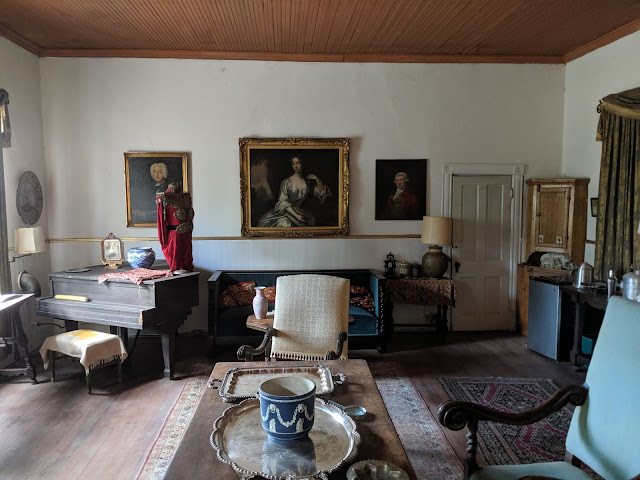Today, I made my last trip into town before heading back to Phoenix. I had meant to get some of these photos every time I passed the signs before. Leaving Gila and heading into Silver City, you cross the Continental Divide and enter the Mimbres Basin Watershed. Going back to Gila, you cross the Continental Divide and enter the Gila River Watershed.
After turning off US Highway 180, a bit before reaching the center of the Town of Gila, you pass a local private airport - the orange item is the wind sock, and obviously, no wind was blowing when I took this phote.
There are five churches in the center of town, along with the library, post office, senior center, youth center and playground, medical clinic and the former village market (it went bust after the recession of 2008). What is now the Catholic Church was the church built as part of the Lyons and Campbell Ranch for the 100 or so Mexican families that lived on and worked at the ranch (see my blog post from August 17, 2019). All the churches and the buildings listed above are all within a couple of hundred yards of each other.
The Catholic Church is just about the Church of Jesus Christ Latter Day Saints (Mormons) and is not far from the Lyons and Campbell Ranch we visited the day before (the L.C. Ranch is to the left on LC Lane).
Just past the church is Hooker Lane, which we follow for three miles before turning on to Double E Ranch Road for the final 3/4 mile to our rental.
As I drive on Double E Ranch Road down the hill towards our rental, the green ribbon in this photo is the riparian area along Bear Creek, the source of water for the Double E Ranch.
So ends our time in Gila, NM, but for packing up, cleaning up and driving back to Phoenix.
After turning off US Highway 180, a bit before reaching the center of the Town of Gila, you pass a local private airport - the orange item is the wind sock, and obviously, no wind was blowing when I took this phote.
There are five churches in the center of town, along with the library, post office, senior center, youth center and playground, medical clinic and the former village market (it went bust after the recession of 2008). What is now the Catholic Church was the church built as part of the Lyons and Campbell Ranch for the 100 or so Mexican families that lived on and worked at the ranch (see my blog post from August 17, 2019). All the churches and the buildings listed above are all within a couple of hundred yards of each other.
The Catholic Church is just about the Church of Jesus Christ Latter Day Saints (Mormons) and is not far from the Lyons and Campbell Ranch we visited the day before (the L.C. Ranch is to the left on LC Lane).
Just past the church is Hooker Lane, which we follow for three miles before turning on to Double E Ranch Road for the final 3/4 mile to our rental.
As I drive on Double E Ranch Road down the hill towards our rental, the green ribbon in this photo is the riparian area along Bear Creek, the source of water for the Double E Ranch.
So ends our time in Gila, NM, but for packing up, cleaning up and driving back to Phoenix.









































































